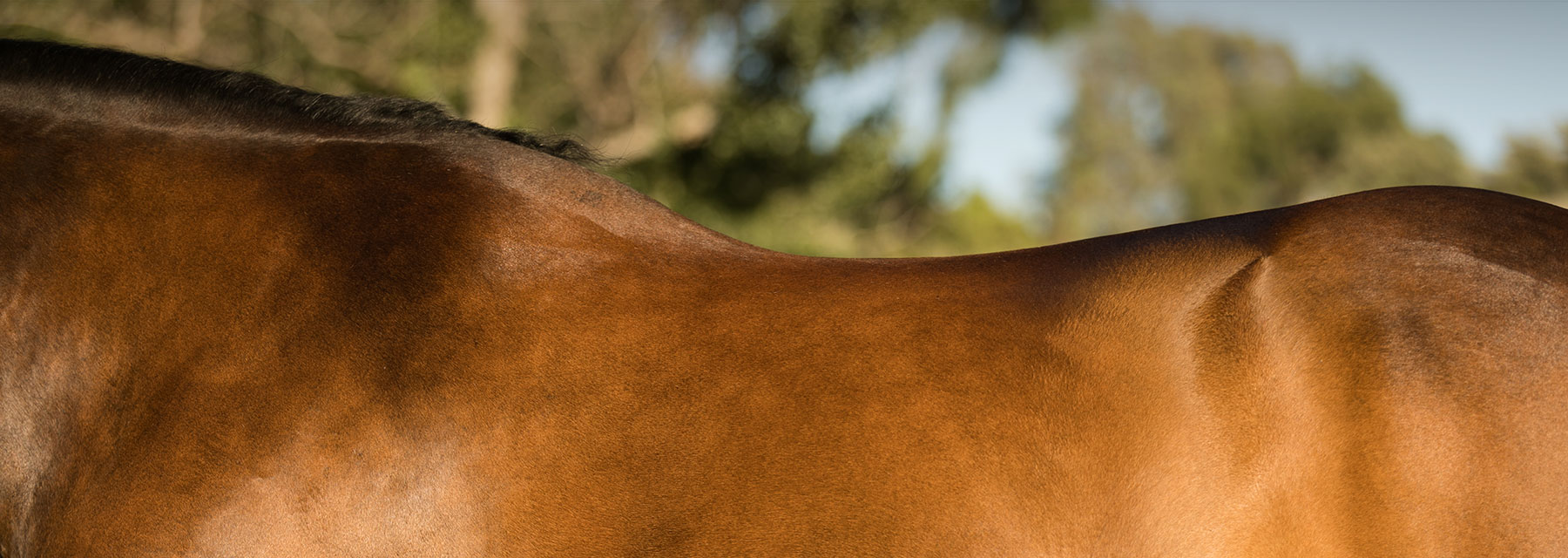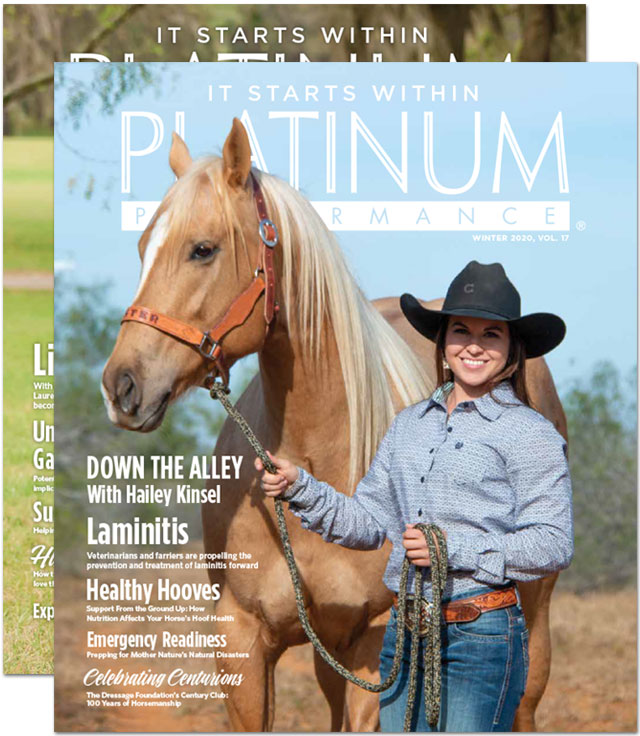This Vitally-Important Collection of Muscles Requires Not Only Specific Conditioning But Also The Proper Nourishment
Core muscles are vital to every horse's capacity for performance and longevity. A strong “core” refers to the collection of muscles along the back, neck and hindquarters and is fundamental to movement. Commonly referred to as the topline, this muscle group allows the horse to walk, gallop, jump and pivot. It safeguards the spine and is central to whole-body stability and strength. The equine topline plays a significant role in a horse's ability to exert itself with adequate protection from injury. All horses require a well-conditioned and well-nurtured topline to feel their best, with particular importance for the equine athlete's ability to perform and recover. Exercise conditioning, proper diet and targeted supplementation all must come together to build — and maintain — the ultimate topline.
“Building a topline” is generally thought to refer to the tone of what can be seen with the naked eye: the neck, withers, back, loin and croup. However, veterinarians think of the topline beyond what can be seen externally. Their anatomical knowledge allows them to dive deeper into the musculoskeletal infrastructure that includes heavy-hitting muscles like the trapezius, longissimus dorsi, superficial gluteal, biceps femoris and more. The multifidus muscle and sacrocaudalis dorsalis lateralis work to stabilize the spine and neutralize excessive movement of a highly-mobile vertebrae in the back, acting as an extension of the multifidus in the lumbar spine region respectively. These hidden muscular gems can significantly impact a horse's athleticism.
The intricacies of the topline are complex. Fortunately, assessing the superficial, most visible topline muscles can be used to determine if a horse is being appropriately conditioned and nourished. These key muscles that surround and support the spine make up only a portion of the core; however, they are the easiest to readily and subjectively assess. A strong topline requires a multi-layered approach and knowing if the horse's superficial topline muscles are thriving is a simplified gauge of whether the deeper muscles are also receiving suitable exercise and nutrition.
The Role of Exercise and Conditioning
General exercise and fitness, along with specific conditioning techniques targeting the core and back, are essential for a toned, healthy topline. Hill work is often advocated under saddle to build topline, with a focus of going slowly, especially down hills, for controlled core work. From the ground, it is often recommended to have the horse back a few steps, again slowly, to help engage the core and hind end. Pole work at a walk or trot can support balance and overall topline with the goal of keeping the horse long, low and relaxed. Exercises, often called “carrot stretches,” are helpful (and fun) ways to stretch, tone and engage the neck and back from a standing position (see Toning the Topline: Exercises That can Help).
Veterinarians and, more specifically, board certified sports medicine and rehabilitation specialists, are able to provide many proven techniques to assist a horse in building the topline in a safe and effective manner. Melissa King, DVM, PhD, DACVSMR, of Colorado State University, is a pillar of the American College of Veterinary Sports Medicine and Rehabilitation (ACVSMR). An expert in her field, Dr. King is widely respected and a strong advocate for building and maintaining an ideal equine topline.
Dr. King recommends implementing “exercises aimed at stimulating motor control, flexibility and stability” and points out they are “regularly employed in human physical therapy programs.” The goal being to activate the deep muscles thereby improving the horse's ability to support its core and back. “Institution of dynamic mobilization exercises over a 3-month time period have been shown to increase both size and symmetry of the multifidus muscle,” Dr. King adds, referencing a 2011 study (N.C. Stubbs, et al). She continues, “The ability to maintain or improve the horse's core muscular strength during the rehabilitative period will reduce the risk of secondary injuries upon return to work and will aid in athletic performance.” Every horse is an individual, and it is important to tailor a unique program to each horse under the supervision of the animal's veterinarian.
Toning the Topline: Exercises That Can Help
Dr. Melissa King, of Colorado State University, recommends exercises to help stimulate motor control, flexibility and stability to improve the horse's ability to support its core by activating those deep muscles.
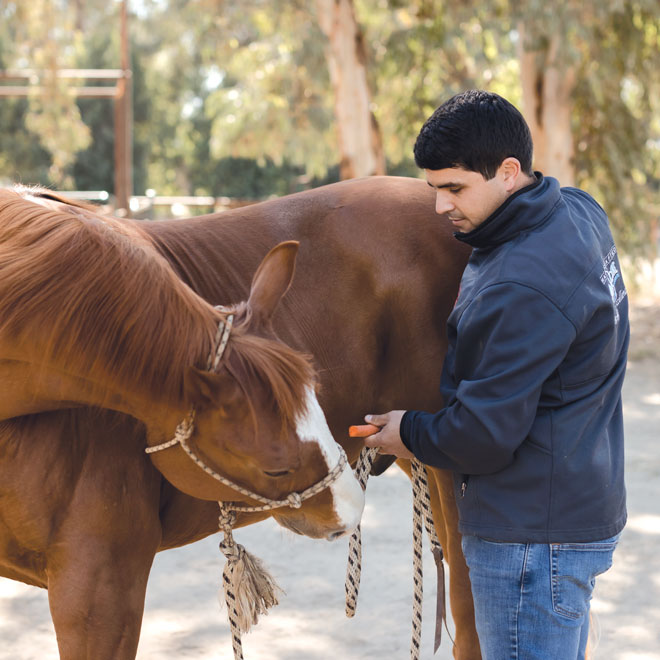
Lateral Bending to the Stifle
One set of five repetitions in both directions four to five days per week.
- Begin by standing square on a flat, level surface in a neutral position.
- Using carrots or cookies as encouragement, ask your horse to bend their neck around toward the stifle and hold the position for five seconds (one repetition). Try not to allow them to reach and snatch but rather to hold the stretch. A long carrot is the best bait; aim to use one carrot per side.
- To prevent the horse from “cheating,” be sure to have them stand close to the wall (i.e. stall wall), so they cannot step away from the stretch. Rotation of the poll is also “cheating.” Aim to keep the top of the poll parallel to the ground and the ears upright to minimize this.
- Complete the stretch slowly and in a controlled manner to ensure optimal muscular engagement of the neck and back.
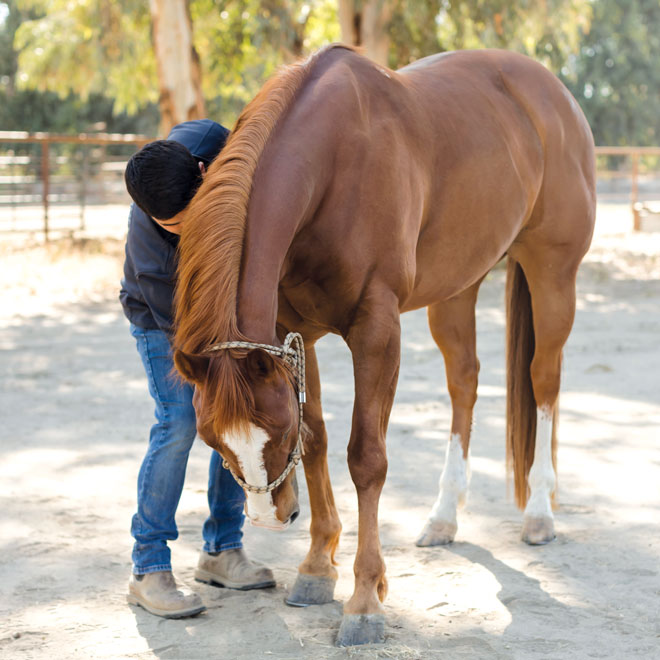
Ventral Flexion to the Front Fetlocks
One set of five repetitions four to five days per week.
- Begin by standing square on a flat, level surface in a neutral position.
- Using a carrot or cookie as encouragement, ask your horse to stretch down with his head and neck between the front limbs — aiming for the level of his fetlocks. This will encourage flexion of the neck and lifting of the back. Ask them to hold the stretch for five seconds, then relax to the neutral position (one repetition).
- To avoid “cheating,” you may need to have your horse stand with their hindquarters in a corner to prevent them from backing up.
- They may also bend or “buckle” at the knees. If this occurs, ask for less of a stretch (stop in front of fetlocks) until they have learned the correct stance.
- Aim for the stretch to be performed slowly and gradually.
Nutrition for the Topline
Three-time winner of the World's Toughest Triathlon and fitness trainer to the stars, Peter Park states simply: “You can't out-train a bad diet.” This advice holds true for horses as well, and the diet is a key component to the equine topline. An imbalance in nutrition can actually cause muscle loss during exercise. The delicate balance between muscle building (anabolism) and breakdown (catabolism) is called muscle net balance. Adequate calorie supply and availability of protein as essential amino acids swing the muscle net balance pendulum toward the anabolic side or a muscle building state. Conversely, a lack of or improper nutrition can lead to catabolism, which is seen as loss of topline. The reasoning for this goes back to the composition of the muscle itself. When water is removed, muscle is made up of approximately 73 percent protein. Supplying balanced and adequate nutrition necessary for the buildup and breakdown of protein is imperative to the function and performance of the topline. A combination approach that includes fitness and appropriate nutrition, including caloric and amino acid content, is needed for optimal success.
5 Steps to Support a Strong Topline
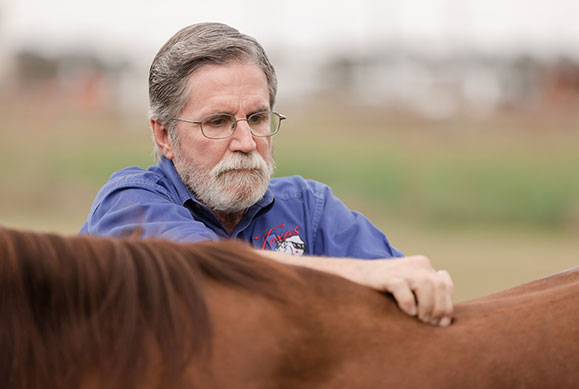
- Evaluate your horse's topline muscling
surrounding the spine. Look for areas that are sunken or not supportive. - Include core-strengthening exercises
daily during groundwork or under saddle, building up slowly. - Adjust your horse's diet
to supply enough calories and a bioavailable source of essential amino acids. Increase content or ratio, by using forage, feed or a healthy oil, like Platinum's Healthy Weight. If feeding a low-protein forage, consider adding a small amount of alfalfa daily. Add a Platinum Performance® wellness formula to balance a forage-based diet. - Support with supplements.
Use formulas with muscle-supporting nutrients for performance and recovery. Consider BCAAs, especially for older horses. - Be patient.
Building a topline can take time, from weeks to months. Re-assess progress every 30 days.
Protein and Amino Acids
Protein, consisting of long chains of amino acids, assists in the synthesis and repair in a multitude of tissue types, including muscle tissue. When a horse eats forage, feeds and supplements that contain protein, it is digested by the horse and broken down into specific amino acids. These individual amino acids are absorbed into the bloodstream where they can be utilized to build and repair specific body proteins, including muscle tissue, as well as synthesize critical enzymes and hormones.
There are approximately 20 naturally-occurring amino acids circulating in the bloodstream that make up most equine proteins. Ten are considered “essential” and need to be consumed by the horse on a daily basis. Essential amino acids must be supplied in the right amount and ratio in the diet. Lysine is often referred to as the first limiting amino acid in the horse. This means that even if adequate amounts of all the other amino acids are supplied by the diet, if there is not enough lysine, the body will not be able to synthesize proteins to build and maintain muscle. The other 10 amino acids are conditionally essential, or non-essential amino acids, meaning that a normal, healthy horse can generally produce enough within the body through hindgut microbial synthesis to meet daily maintenance needs. However, in times of stress or exertion, the non-essential amino acids, such as glutamine, may need to be supplemented to ensure enough is available to the horse. In order to maintain a multitude of tissues and functions, the body needs both essential amino acids and non-essential amino acids in adequate supply on a daily basis.
In equine feeds, protein content is measured via crude protein analysis. This determines its nitrogen content, and that number is multiplied by 6.25 to give the crude protein content on a feed tag. In some species, such as swine, research has determined specific amounts and ratios of protein required in the diet. Equine research is ongoing as horses have a much more complex digestive system and a highly-variable dietary component seen in their forage intake. Horses do not actually have a dietary protein requirement, per se, but rather have an amino acid requirement. While the guaranteed analysis of a commercial feed lists few specific amino acids that are guaranteed at certain quantities, there are other factors to consider beyond the label, including the digestibility and bioavailability (absorbability) of those nutrients. While forages may be quite high in protein — and even in lysine for example — it is impactful where that forage is digested: in the foregut (stomach and small intestine) or hindgut (cecum and colon). The foregut is where the individual amino acids are absorbed into the bloodstream. In one study (Gibbs et al., 1988), an immature alfalfa hay was estimated to have a pre-cecal (in the foregut) digestibility of about 28 percent and a coastal hay had around 16 percent. In contrast, the estimated pre-cecal protein digestibility of soybean meal was at nearly 70 percent. A forage-based diet is always the best choice for horses, but it is important to remember that even if high in protein, it is the total amino acid intake that matters, including contributions from forage, feeds and supplements combined. Lastly, it is important to note that more is not necessarily better. More impactful than quantity is the quality of a protein, and the ratio of individual amino acids to lysine, a concept referred to as the “ideal protein.”
Nutrition to Support the Topline
- Proper diet and exercise are both necessary for building the ideal topline. Discuss with your veterinarian the best dietary and conditioning programs to support your individual horse. Your vet can also give a referral for an equine sports medicine and rehabilitation specialist, if needed.
- High-quality forage paired with a comprehensive daily supplement, like one of the Platinum Performance® wellness formulas, deliver essential nutrients, including amino acids, needed to meet nutritional requirements and support muscle health. Make any dietary changes slowly.
- High-performance athletes may need additional muscle support depending on the individual.
Platinum Formulas for Performance and Recovery:
- Platinum Renew® helps maintain muscle strength, supports endurance and aids in post-exercise recovery, including soreness and fatigue.
- Myo-Vet® supports muscle development and function, supporting lean muscle mass and recovery from exercise.
- Platinum BCAA supports a horse's ability to maintain muscle tissue and glycogen stores and also supports muscle tone and immunity.
- Platinum Power® combines four premium formulas to support cellular energy, circulation, muscle maintenance and overall muscle tone.
Evaluating the Topline
With the equine topline being comprised primarily of muscle, both visual and physical inspection of the topline can offer important indications as to its condition. Physically run your hands over the topline and look for whether those muscles surrounding the spinous processes are supportive or sunken in. This simple observation alone can help illustrate the state of a horse's general amino acid level and whether they are receiving adequate amounts from their diet. Noting the horse's Body Condition Score (BCS) using a 1 to 9 scale is also imperative when evaluating the topline, as horses with a BCS above 6.5 can be more difficult to assess due to fat accumulation over the topline. Muscle and fat will feel different when palpated, but the presence of excess fat can complicate a clear physical and visual assessment.
Problem Toplines
There are instances where, even with an ideal diet and conditioning program, a horse will continue to struggle with a sunken or insufficient topline. Some horses with primary back issues or neurologic diseases, like Equine Protozoal Myeloencephalitis (EPM), will lose topline muscle mass. Additionally, genetics and age-related conditions, including Equine Cushing's disease (pituitary pars intermedia dysfunction or PPID), can also be causative factors. A 2006 study (Monica R. Aleman, et al) showed type 2 muscle fiber loss in horses with PPID, similar to that seen in dogs and humans with the disease, with increasing age being a contributing influence. PPID, though not curable and a common cause of muscle loss in aged horses, can respond to veterinary treatment. Much like in aging humans, a lower level of muscle signaling factor has been noted in older horses; however, in one study, researchers were able to improve lean muscle gain in aged horses by providing the branched-chain amino acids (BCAAs) — leucine, valine and isoleucine. In senior horses, it may be more crucial to ensure an ideal combination of fitness, adequate calories and amino acids. Targeting consistent exercise, BCAAs and a healthy fat source — high in omega-3 fatty acids — may help maintain an aging horse's topline and proper spinal support.
In addition to age and genetics, conformation can cause apparent lordosis (sway back) in some horses. In these cases, specific core exercises can help to support the spine laterally via the topline muscles. A key point to remember is that conformation cannot be undone or altered, but equine care takers can support inherent conformation by improving muscles.
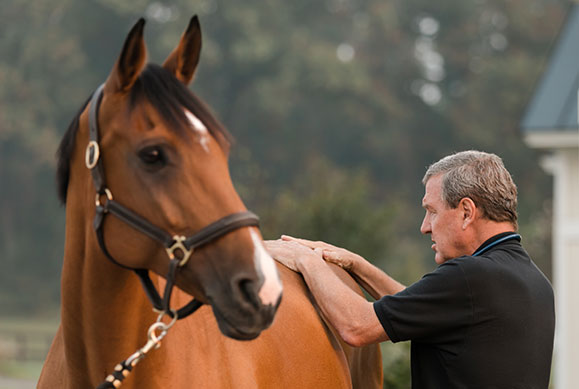
With the equine topline being comprised primarily of muscle and muscle being predominantly amino acids, both visual and physical inspection of the topline can offer important indications as to its condition.
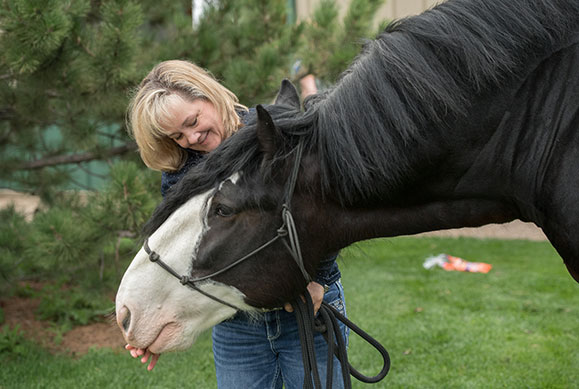
Melissa King, DVM, PhD, DACVSMR, is a Diplomate of the American College of Veterinary Sports Medicine and Rehabilitation and is an associate professor in Equine Sports Medicine and Rehabilitation at Colorado State University.
The Bottom Line on the Topline
Central to a horse's overall health and performance, a strong topline requires a tandem approach of a thoughtful training and conditioning program combined with the proper diet that supplies adequate calories and necessary amino acids. Keeping a horse fit and utilizing specific exercises that target core strength and agility are extremely useful. High-quality forage paired with a daily comprehensive wellness formula, such as Platinum Performance® Equine, Platinum Performance ® GI or Platinum Performance® CJ, will deliver the nutrients most horses need to support healthy muscles. While protein and amino acids are crucial, keep in mind many other nutrients play a vital role. Choosing an optimal source of those nutrients for bioavailability and digestibility is paramount to their effectiveness. Specifically, high-performance athletes may require additional support for muscle recovery, and the horse's veterinarian is the best resource to make recommendations.
The intricacies of the topline may be complex, but its importance in the ability of every horse, especially equine athletes, to exert themselves with adequate protection from injury is well established and important. Implementing a multi-layered approach that focuses on condition and nutrition can give horses a strong, well-nurtured topline, allowing them to live and perform at their very best.
“The ability to maintain or improve the horse's core muscular strength during the rehabilitative period will reduce the risk of secondary injuries upon return to work and will aid in athletic performance.”
— Melissa King, DVM, PhD, DACVSMR, Colorado State University

by Abby Keegan, MS, PAS,
Platinum Performance®

Contributing Veterinarian:
Melissa King, DVM, PhD, DACVSMR
Colorado State University
You May Also Like
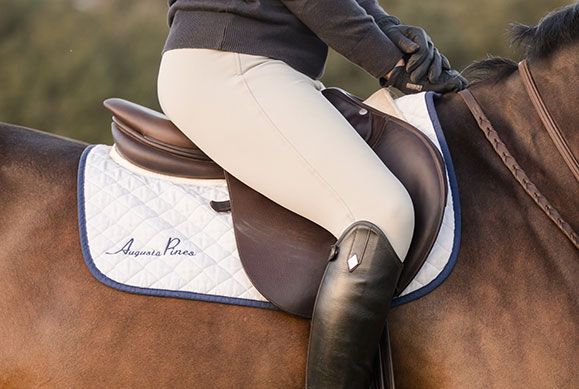
Topline Supplements for Horses
Supporting a strong topline with nutrition.
Read More about Topline Supplements for Horses<
Managing Common Muscle Disorders in Horses
Management procedures and specific dietary interventions can help reduce the severity and the frequency of episodes.
Read More about Managing Common Muscle Disorders in Horses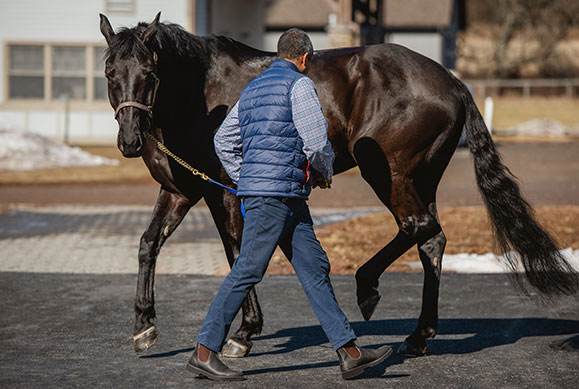
EPM in Horses
The evolution, treatment and prevention of Equine Protozoal Myeloencephalitis.
Read More about EPM in Horses